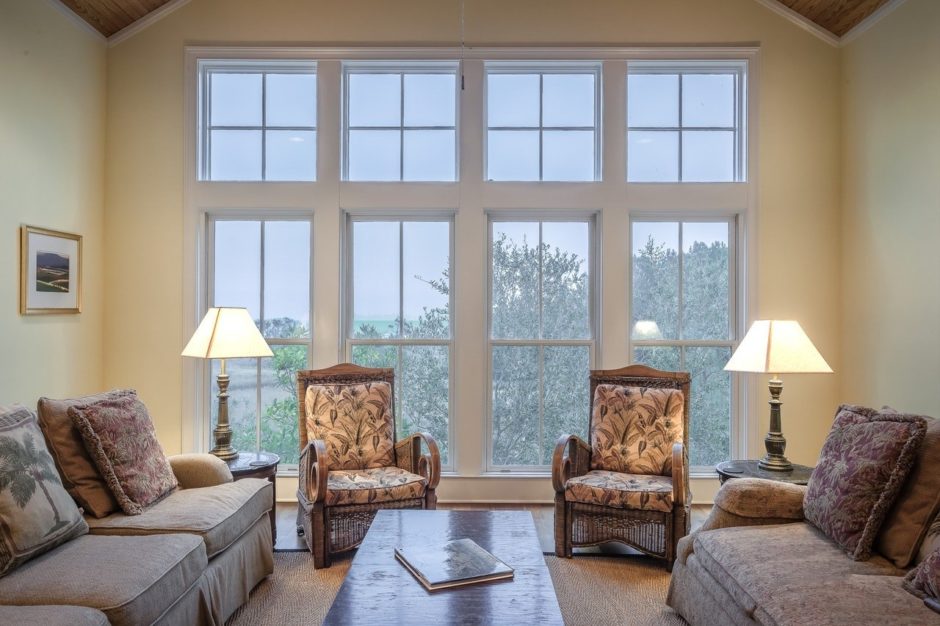The Most Energy Efficient Window Types Compared [2020]
Most homeowners want beautiful windows to compliment their home, but with rising energy costs, perhaps energy efficiency has moved up a few notches on your list of priorities. If you are here to learn about different windows and how to maximize your energy efficiency before buying new windows then you came to the right spot!
From the material of the window frame, to the glass type, glass coating, number of panes, and even the air/gas between the panes can all contribute to massive differences in energy efficiency.
WINDOW FRAME MATERIAL
Assuming the window was installed and sealed properly we can compare the thermal resistance of different materials. Metal is the most conductive of the frame materials mentioned below and thus is the worst insulating frame material since cold air conducts through the metal very easily. Vinyl, fiberglass, wood, and different composite and hybrid materials all perform much better in terms of thermal conductivity.
Aluminum/Metal Window Frames
Despite the lack of thermal resistance, these windows do have many advantages. They can be strong, lightweight, and require very little maintenance to maintain.
Luckily with today’s advances in window designs these widows tyically have a thermal break within the frame with an insulating material in between to prevent heat conducting directly from the home’s interior to outside. Some windows also, have aluminum cladding over another material such as wood – another more energy efficient option.
Composite Window Frames
Composite window frames combine some qualities of vinyl and wood windows. They often try to capture a wood frame appearance while being a much more waterproof material than wood. Most composite window frame materials consist of composite wood products, such as particleboard and laminated strand wood, and some are mixed with polymer plastics. This processing of materials makes the window much less susceptible to rotting and decay due to moisture.
Wood Window Frames
Wood window frames are expensive and often the window frame material of choice in many high end homes with classical designs or in historical restorations. Wood frames naturally insulate pretty well – much better than metal, but not as good as insulated fiberglass or vinyl. The main issue with wood windows, however, is the maintenance that comes with these elegant windows. Of all these materials, wood is the most vulnerable to weather and moisture. If not maintained properly the windows could get warped or rot prematurely from moisture getting within the frame. Wood windows can have different kinds of exterior cladding, such as aluminum, which may reduce energy efficiency slightly, but may weather the elements better.
Fiberglass Window Frames
Fiberglass window frames are are very strong and are made with many spaces within the frame. If these spaces within the window frame are filled with insulation the windows can have far superior energy efficiency than wood or composite frames.
Vinyl Window Frames
Vinyl window frames have become extremely popular in america and are often the most cost effective option. These windows typically require very little maintenance, do not need to be painted, and are very resistant to weather and moisture. The vinyl material is typically made out of PVC which usually contains (UV) stabilizers to prevent the sun from breaking it down. Vinyl window frames, like fiberglass windows, have a similar structure and can be filled with insulation making them more energy efficient than wood frames, or uninsulated vinyl windows.
GLASS
When it comes to glass options for your windows there plenty of decisions to make. The first decision is the number of panes. Most insulating windows are double pane, meaning two layers of glass with a space in between. Triple pane windows are also insulating windows used relatively often and sometimes even quadruple pane. More panes, means more insulation, but also more light is prevented from entering the home. This is often where the home’s orientation comes into play. For example, triple pane may be used on the side of the home that gets less sunlight (such as the north side if you live in DC) and may put double pane on the southside to allow more heat from the sun to come in in the winter.
The light that enters the window can also be manipulated drastically by the coating on the window panes:
Low-Emissivity Coatings
Have you seen a building with reflective-looking glass? It likely had a coating on its glazing such as a low-e coating.
Low-emissivity (low-e) coatings are a super thin metal oxide layer control thermal heat transfer through windows with insulated glass. According to the Department of Energy, “windows manufactured with low-e coatings typically cost about 10% to 15% more than regular windows, but they reduce energy loss by as much as 30% to 50%”. Low-e coatings can be designed to optimized solar gain for colder climates, or low solar gain for warmer climates.
Spectrally Selective Coatings
Spectrally selective coatings are unique kinds of low-e coatings designed to prevent a large amount of heat to transmit through the glass, but allow as much light as possible to come through. Typically this involves the window coating reflecting the infrared rays from the sun specifically, while allowing the other wavelengths through. The Department of Energy says they can filter out “40% to 70% of the heat normally transmitted through insulated window glass or glazing while allowing the full amount of light transmission”. This can reduce a building’s electric cooling expenses by upwards of 40% in hot climates.
GAS BETWEEN THE PANES
When considering the thermal conductivity of a window through it’s glass, a big part of the equation is the air between the panes – which makes a huge difference. The preferred options are argon and krypton, which are both inert, invisible, odorless gases. Argon and krypton can greatly decrease heat transfer compared to regular air.
TYPE OF WINDOW
The final factor that plays a large role in the window’s energy efficiency is the window’s operating type – meaning how the window opens. Assuming the frame is installed ideally there should be very little air leakage around the frame, but when it comes to the actual window – if the window opens, it will have some air leakage.
Thus, fixed or picture windows are technically the most energy efficient in terms of air leakage since they are fully sealed and do not open. The next most energy efficient windows would be one where the opening part of the window closes flush against the frame like a door, such as a casement or awning window. The windows that have the most air leakage are windows that slide since they do not close flush with the frame and there is mosr space for air leakage, such as double hung windows.
References:
“Window Types and Technologies”. Department of Energy. Energy Saver. Web. Accessed 12/17/2019. https://www.energy.gov/energysaver/window-types-and-technologies

